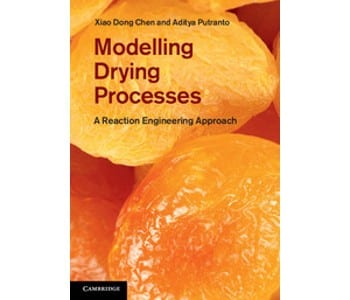 Modelling Drying Processes: A Reaction Engineering Approach
Modelling Drying Processes: A Reaction Engineering Approach
By Xiao Dong Chen and Aditya Putranto
Hardcover / eBook
ISBN: 9781107012103
252 pages
£75 / $96
Click here for more information
Reviewed by Dr. Ching Lik Hii, University of Nottingham
Drying is a complex simultaneous heat, mass and momentum transfer operations which aims to reduce the moisture content of a product, primarily for the purpose of preservation especially for foodstuff. The kinetics or rates of drying are the governing factors that determine the end product quality such as colour, texture, shrinkage, flavour, odour, rehydration, nutrients and etc. Mathematical modelling is often used in dryer design to link between the transport processes and the evolution of product quality attributes during drying. Conventional modelling methods usually fall into 3 categories namely i) the characteristic drying rate curve (CDRC) method ii) the distributed parameter models (using heat and mass transfer equations) and iii) the empirical method. These methods are also widely used and reported in many drying literatures.
In this book, the authors presented the theory and applications of the Reaction Engineering Approach (REA), which is a ‘middle path’ approach (according to Chen), between the empirical and the mechanistic models. REA was first proposed in 1996 and it was initially intended to be used for small size materials with very small Biot number (Bi<0.1). It utilizes the concept of activation energy which describes the difficulties involved in extracting moisture at the various stages of drying. The inherent advantage of REA is that it enables drying studies to be conducted in a single and carefully executed drying experiment and this would serve as a ‘fingerprint’ that can be used to predict the kinetics of other drying experiment i.e. at different operating conditions for a similar product. One of the chapters has presented the modified Biot and Lewis number analysis that takes into account the evaporative effect.
The authors have included several examples of REA applications in drying i.e. spray drying, infrared drying, intermittent drying, microwave heating and baking. Studies using several types of food and non-food materials are also presented such as mango, potato, bread, cake, polymer and wood. REA can be applied as a lumped model (L-REA) which excludes the need to solve for the spatial distribution of moisture content. For studies that require the values of the moisture content to be known within the product matrix, the Spatial-REA (S-REA) method can be used. The advantages/disadvantages between REA and various theories of drying are also presented.
In summary, this book provides a very good introduction of the use of REA in drying which is highly recommended to researchers that are embarking in an innovative approach in mathematical modelling and even in computational fluid dynamics studies.

















